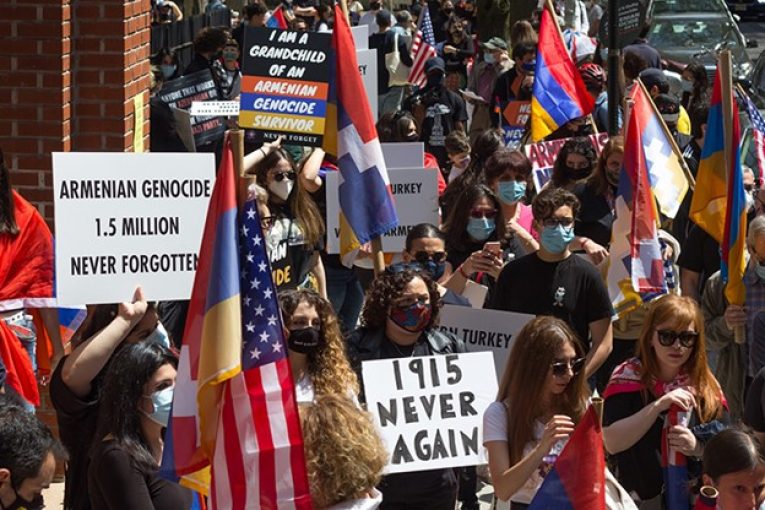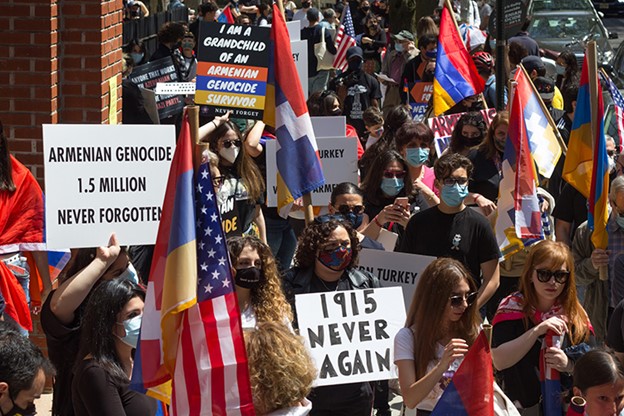

By Eric Gelber
On April 24th, President Biden officially recognized the massacre of Armenians under the Ottoman Empire as genocide. It’s unclear how many Americans were even aware of this history. However, a recent study of 18-to-39-year-old adults’ knowledge and perceptions of the Nazi Holocaust would suggest that awareness is likely low. SB 693 (Stern) would address this knowledge gap about the Holocaust and other recent and historical instances of genocide to help ensure that the admonishment of “Never Again” is not an empty promise.
What problem/issue would the bill address?
Although aspects of its methodology have been criticized, a recent survey of 1,350 millennials and Gen Z adults conducted by Schoen Cooperman Research found, for example, that:
- Almost 2/3rds of young American adults do not know that 6 million Jews and 5 million others were killed during the Holocaust.
- 11% (13% in California) believe Jews caused the Holocaust.
- Almost half (48%) could not name a single concentration camp or ghetto established during World War.
- 23% believed the Holocaust was a myth, or had been exaggerated, or they weren’t sure.
- 12% said they had definitely not heard, or didn’t think they had heard, about the Holocaust.
- 22% said the Holocaust was associated with World War I.
- 49% had seen Holocaust denial or distortion posts on social media or elsewhere online.
- 19% say, ‘Jews still talk too much about what happened to them in the Holocaust.’
- 70% say fewer people seem to care about the Holocaust than they used to.
- 58% believe something like the Holocaust could happen again.
According to the author of SB 693, “[a]s our collective memory fades and we lose the last generation of survivors, we must redouble our commitment to educate the next  generation and refuse to slip into the same apathy and ignorance that allows hatred to take root.” Senator Stern continued, “On January 6, I sat with my father-in-law, who survived Auschwitz as a teenage boy, watching in horror as domestic terrorists stormed the U.S. Capitol. One of the men tearing down the Speaker’s door wore a ’Camp Auschwitz’ sweatshirt. A greater horror set in at that moment—that thousands of young people in our community, and across our state and nation, watching this siege unfold, would have no idea what that sweatshirt meant, what Auschwitz was, and that hatred has a history.”
generation and refuse to slip into the same apathy and ignorance that allows hatred to take root.” Senator Stern continued, “On January 6, I sat with my father-in-law, who survived Auschwitz as a teenage boy, watching in horror as domestic terrorists stormed the U.S. Capitol. One of the men tearing down the Speaker’s door wore a ’Camp Auschwitz’ sweatshirt. A greater horror set in at that moment—that thousands of young people in our community, and across our state and nation, watching this siege unfold, would have no idea what that sweatshirt meant, what Auschwitz was, and that hatred has a history.”
What would the bill do?
SB 693 would establish the Governor’s Council on Genocide and Holocaust Education, comprised of 17 members appointed by the Governor who have particular interest or expertise on genocide, including the Holocaust. The bill would require the council to develop best practices to facilitate the instruction for pupils in grades 4 to 12 on genocide and the Holocaust, identify available resources that are aligned to the best practices, and identify programs and resources to train teachers to provide education on genocide and the Holocaust.
The bill would also require the California Department of Education to make available the best practices and approved lessons, resources, and materials to support the integration of instruction on genocide and the Holocaust, and to conduct a voluntary study to assess the impact of the instruction based on the best practices.
The best practices would encourage innovation, equity, accessibility, and flexibility, and leading to instruction designed to do all the following, where appropriate:
- Prepare pupils to confront the immorality of genocide, the Holocaust, and other crimes against humanity, such as events in Nanjing, China, and Japanese internment camps during World War II, and to reflect on the causes of related historical events.
- Address the breadth of the history of the Holocaust, including the Third Reich dictatorship, concentration camp system, persecution of Jews and non-Jews, Jewish and non-Jewish resistance, and post-World War II trials, and other genocides perpetrated against humanity, including, but not limited to, the Armenian Genocide, the Genocide against the Tutsi in Rwanda, and other genocides committed in Africa, Asia, Latin America, South America, and Europe.
- Develop pupils’ respect for cultural diversity and help pupils gain insight into the importance of the protection of international human rights for all people.
- Promote pupils’ understanding of how the Holocaust contributed to the need for the term “genocide” and led to international legislation that recognized genocide as a crime.
SB 693 would “strongly encourage” school districts and charter schools to integrate the best practices into instruction on genocide, including the Holocaust.
Comments
In 2020, Anti-Defamation League (ADL) recorded 2,024 antisemitic incidents in the United States. Incidents were reported in 47 states as well as the District of Columbia. The states with the highest numbers of incidents were New York: 336, New Jersey: 295, California: 289, Florida: 127 and Pennsylvania: 101. Combined, these states account for nearly 57 percent of the total number of incidents. While anti-Semitic incidents declined by 4 percent after hitting an all-time high in 2019, last year was the third-highest year for incidents against American Jews since ADL started tracking these data in 1979.
As lockdowns related to the pandemic began in March of 2020, incidents in schools and on college campuses decreased as learning moved online. “Zoom-bombing”—the intentional disruption of live videoconferences—rose significantly in 2020. ADL recorded 196 incidents of antisemitic videoconferencing attacks last year, of which 114 targeted Jewish institutions such as schools and synagogues.
The ADL has recommended that school districts promote anti-bias, bullying prevention and Holocaust and genocide education programs in elementary and secondary schools: “Echoes & Reflections, a partnership among Yad Vashem, ADL, and the USC Shoah Foundation to develop Holocaust curricula, released a survey in 2020 showing that high school students who studied the Holocaust have more pluralistic attitudes; are more willing to challenge intolerant behavior in others; and have a greater sense of social responsibility and civic efficacy. In today’s climate of heightened antisemitism, anti-Asian scapegoating, and systemic racism, nurturing these values in young people could not be more important.”
The Senate Education Committee staff analysis of SB 693 noted that the Holocaust and other genocides are currently referenced in several California Department of Education curriculum documents,
including the Model Curriculum for Human Rights and Genocide, which was originally developed in 1987 and addresses the Armenian, Cambodian, and Rwandan Genocides; and the History–Social Science Framework, which underwent a major revision in 2016 and contains extensive content on the Armenian Genocide and the Holocaust and mentions several other examples of genocide. Genocide is also addressed in the Ethnic Studies Model Curriculum that was recently adopted. Based on this, it is likely that SB 693 will be amended as it proceeds through the legislative process to minimize duplicative resources.
There was no registered opposition to SB 693 when it was heard in the Senate Education Committee on April 14th. It was passed by the Committee on a 7-0 vote and is scheduled to be heard in the Senate Appropriations Committee on May 3rd.
Eric Gelber, now retired, is a 1980 graduate of UC Davis School of Law (King Hall). He has nearly four decades of experience monitoring, analyzing, and crafting legislation through positions as a disability rights attorney, Chief Consultant with the Assembly Human Services Committee, and Legislative Director of the California Department of Developmental Services.
Support our work – to become a sustaining at $5 – $10- $25 per month hit the link:

Reminds me of the original version Gilligan’s Island theme song “and the rest” — Not OK. Name the “others” — Here’s a partial list: Slavs, Poles, Ukrainians, Soviet Slavs and POWs, Romani, Spanish Republicans, non-Europeans, people with disabilities, gay men and lesbians, political victims and prisoners, leftists, enemy nationals, Jehovah’s Witnesses, Roman Catholics, Protestants, Baháʼí Faith, Freemasons.
The Professor and Maryanne, daµµit!
Excellent! Needed to be said…
And that was just 30’s and 40’s… about a generation before, it was the Armenians… before that, “opening the west” (with the concomitant concept that “the only good Indian is a dead Indian”).
Other places as well, more recently, where there were ‘ethnic cleansings’, ‘political purges’, and/or ‘religious purifications’… India, Rwanda, Russia, Cambodia, Yugoslavia, Mexico… and (apologies to Alan M) “all the rest”…
The article seems to say that the more general issue, “how do these atrocities happen, what led up to them, how we can avoid ‘repeats’?” is at least ‘on the table’… those questions, appear to be more important than the “learning who did what to who, when”… that is the background, to be sure, but it is ‘blood/lives under the bridge’… the focus should be more on the “Never Again!”
Particularly now, given much of the rhetoric in the US, and elsewhere in the world… it could “happen again”… if we are not vigilant…
I think it’s great this will be taught, especially in the context of other genocides – as I think the sheer numbers of the Holocaust tend to minimize the horror of genocide more widely, and the understanding this has happened repeatedly. This is most important as “never again” means nothing as it has happened again, many times, since WWII – Rawanda, Cambodia . . . and this must be stressed . . . and maybe an oversight, but no mention of the US treatment of our indigenous people. If native populations diminishing from about 10 million when settlers came to about 300,000 by 1990 (helped along by small-pox blankets, relocation and numerous wars) is not a genocide, then what is?
Is this bill the right means? I don’t know. Considering the repeated complaints from Jewish groups about the flaws in proposed ethnic study bills, this may be necessary to counter that — but all these bills stink a bit of goody-goody-ism by multiple, conflicting government decrees that I’m not convinced can be implemented. Only the outcome will tell for sure. I and many others were taught “history” from a WASP perspective only on America, and we only made it up to about 1860 in the history text before we graduated and moved on to college. I don’t know where you find the extra time in the school day or some better way to teach, to get all this new mandated learnin’ in.
It’s still happening, in some places around the world.